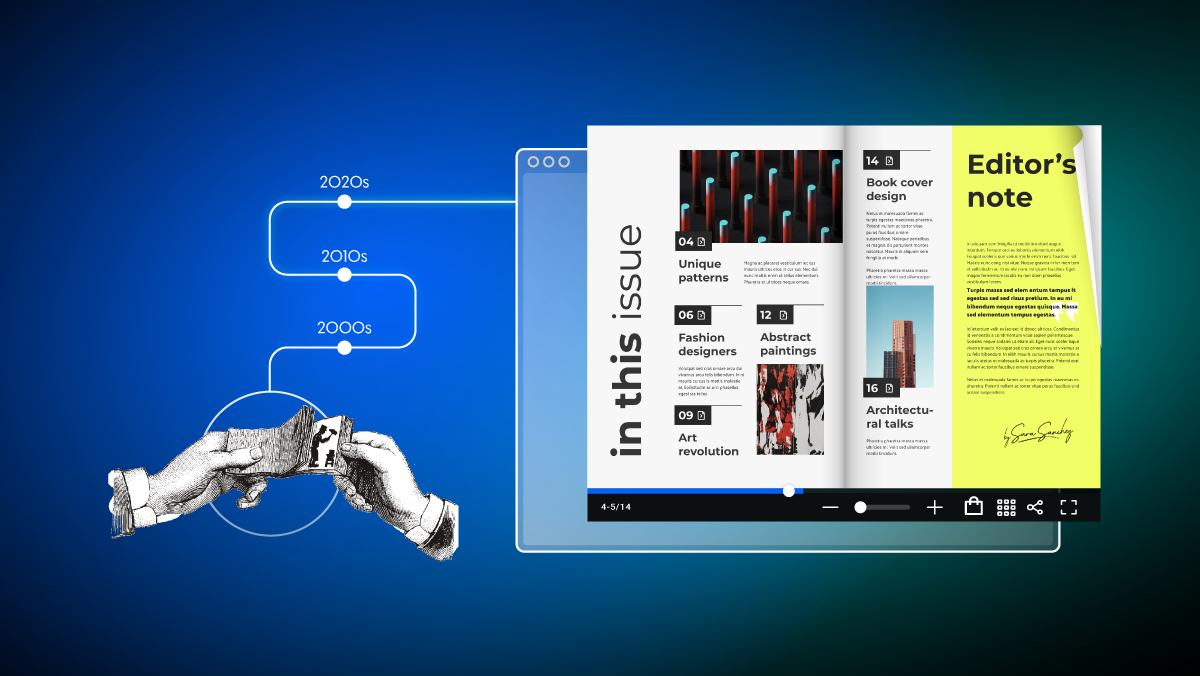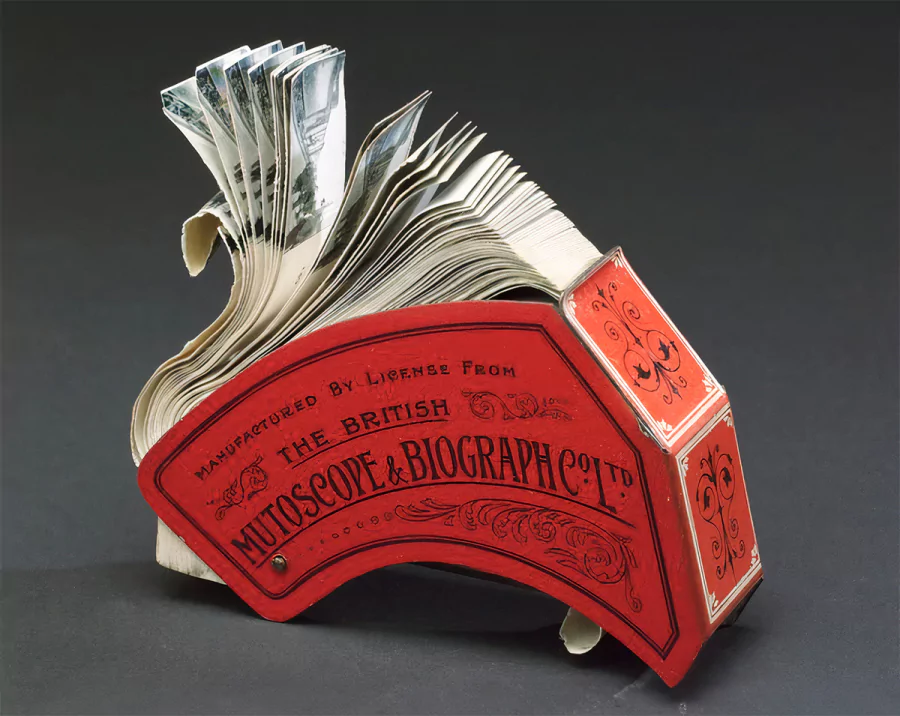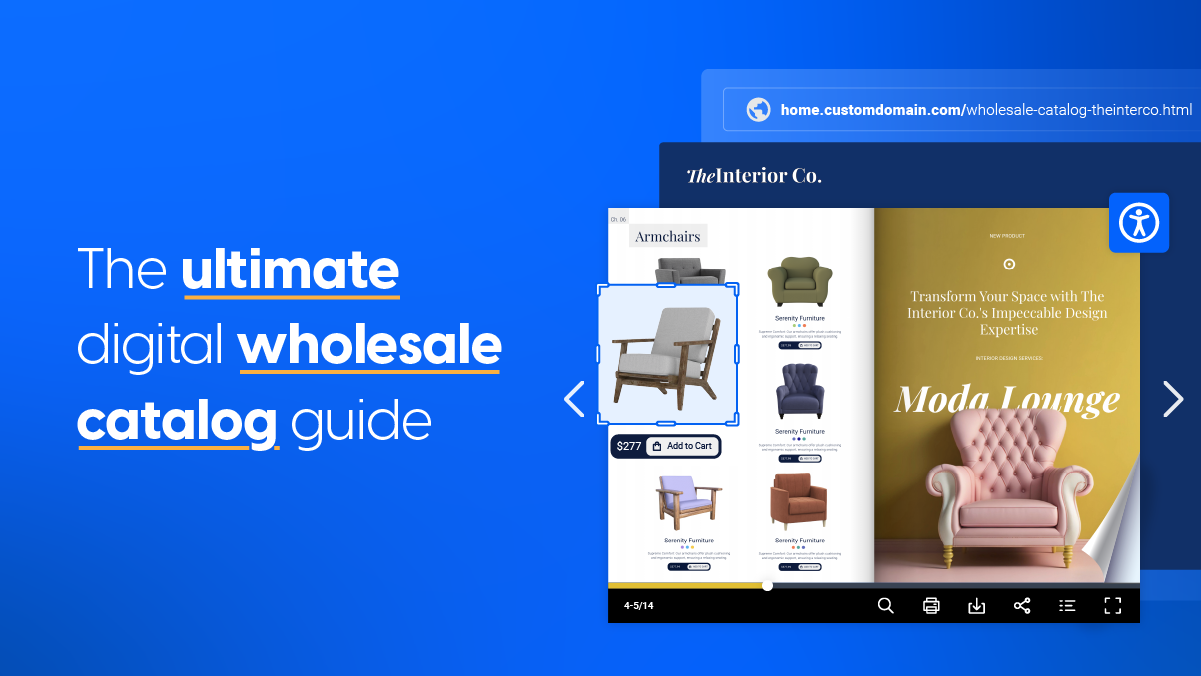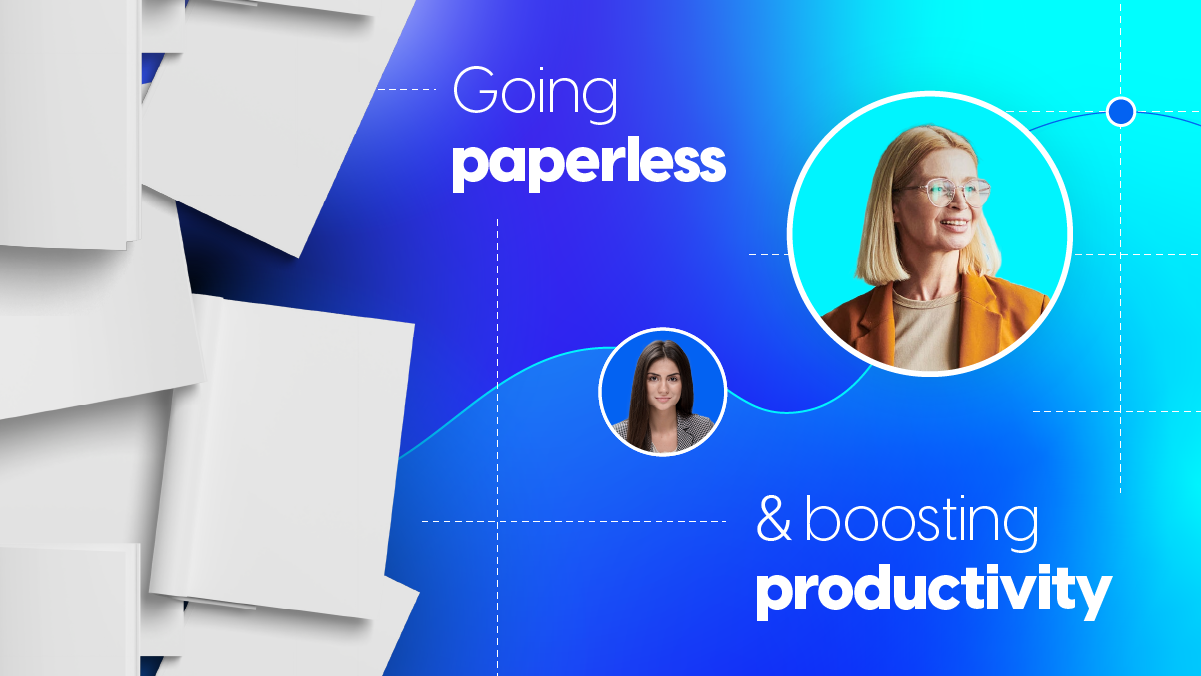The history of flipbooks – from entertainment to business opportunities
What is a flipbook? Depending on what century you’re in, the answer to that question might be a little different. The truth is that flipbooks have evolved from what they once were. Although you might not think it, the history of flipbooks is rich and interesting.
It certainly allowed for the foundation to be poured into what we know digital flipbook animations to be today.
In what follows, we will embark on a journey through the history of flipbooks. We’ll discover the fascinating origins of this art form and explore the technological twists that have shaped the evolution of flipbooks.
Let us see how flipbooks have transformed over the course of time: from humble beginnings to the captivating digital flipbooks we know today.
Table of contents
What is a flipbook?
A flipbook, or kineograph as it is also known, is a type of booklet that contains a sequence of images. These images gradually change from one page to the next, creating the illusion of motion. When the pages of a flipbook are flipped quickly, the images come to life and appear to animate. Traditional flipbooks are usually created for entertainment and are especially popular with children. Here is a short video of a flipbook in action:
What is a digital flipbook?
Although similar in name, a digital flipbook is not the virtual equivalent of a traditional flipbook. A digital flipbook is actually a digital publication that recreates the layout and flippable nature of a standard, printed publication. Think of magazines, brochures, reports, or any other type of publication in digital format with realistic page-flipping animations. Besides the flipbook animation, they also have other advantages, such as complex interactivity, sharing, or privacy options. But more on that a little bit later. Here is a digital flipbook example:
Who invented the first flipbook?
Since the beginning of time, people have been drawing to express themselves. However, it wasn’t until around 1860 that Pierre-Hubert Desvignes was credited for creating the first flipbook. Or, at least, the drawn version.
Eight years later, in 1868, John Barnes Linnett, a lithograph printer for Britain, officially patented the design. Back then, they referred to it as a kineograph, which is Latin for “moving picture.”
Fast forward just a bit to 1897, and English filmmaker Henry Williams would learn how to mechanize this process. Then, it evolved even further into what they called a filoscope. Essentially, each image was placed into a metal bracket to hold it in place. A knob would be turned, thus “flipping” the pages. This was referred to as the mutoscope.
Flipbooks like this are now largely considered to be a novelty or even a toy for children. That being said, back in the late 1800s, they were widely used as a form of entertainment for people of any age. They were quite the advancement in technology, leading the way for flipbooks and even movies as we know them now.
Flipbooks were sold mostly in toy shops and as jokes, purely for simple and cheap entertainment. They were further popularized by The Cracker Jack company in the early 1900s when they gave them away as prizes in their product packs. Soon after, the trend began to pick up, and flipbooks could be found in bubblegum wrappers, cigarettes, and other snack foods.

How flipbooks evolved to be digital
Nailing down the first digital flipbook software is quite a difficult task. Flipbook animation technology has existed for a while now, but it’s still constantly evolving. What we can pinpoint, however, is the first time the word “flipbook” was used for digital software.
Back in 1999, a company called DigiCel decided to make its mark in the history of flipbooks and brought 2D characters to life using its flipbook animation software. Granted, this technology still isn’t what we picture flipbooks to be nowadays, but it is a really good time stamp showing when this technological leap took place. And it’s an important stamp in the history of animation and flipbooks. Here is a timeline of the evolution of digital flipbooks:
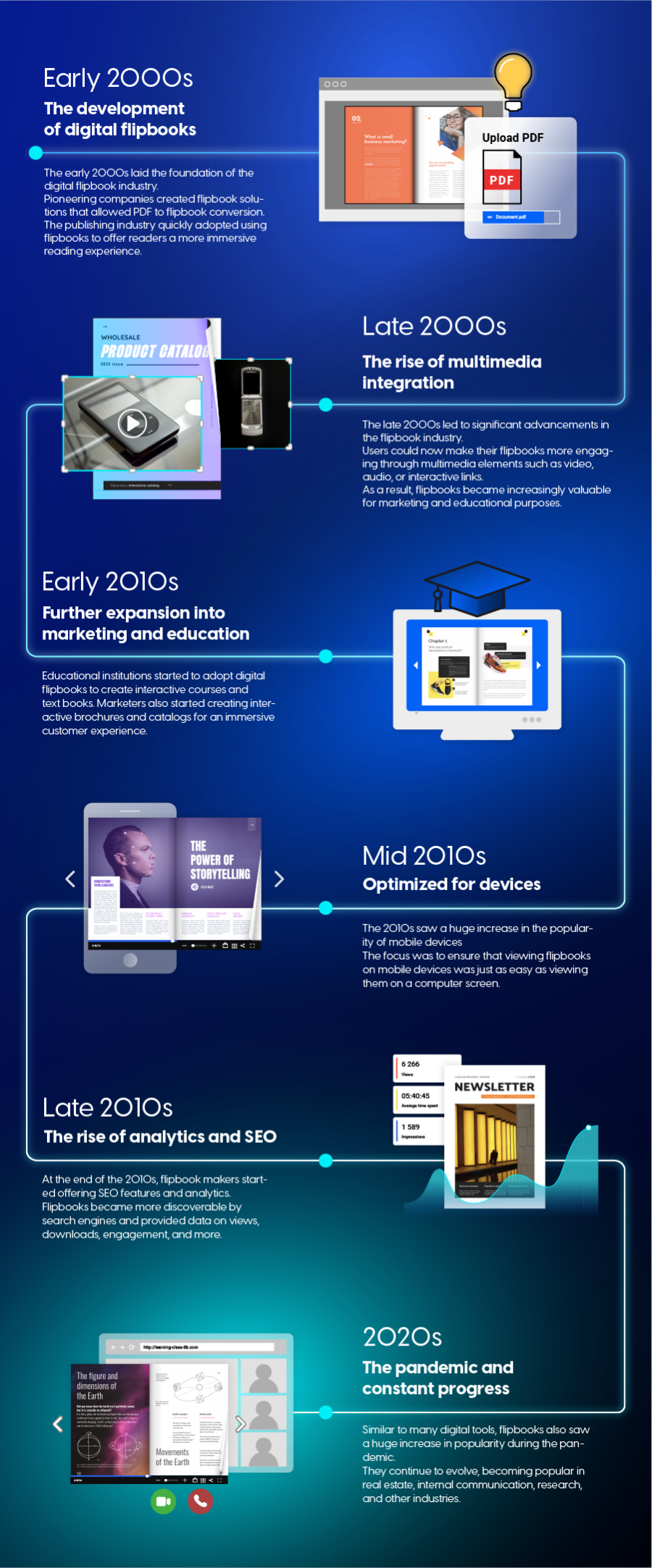
A change in purpose
While the concept of flipbooks remains largely unchanged, there have been significant shifts in how we perceive them. Some people still create drawn flipbooks, but nowadays, digital ones come to mind when one thinks of flipbooks. To prove this point, search for “flipbooks” in any search engine, and you will see that the top results are related to digital flipbooks.
So when you think about it like that, the history of flipbooks has changed completely over the 150+ years they’ve existed. Everything about them has changed, right down to their very definition. Instead of being used strictly for entertainment, they’re also used for business and education. What started as a hobby has slowly become a tool that has transformed how businesses operate and children learn.
Flipbooks went from simple pieces of paper glued together and flipped through to digital publications that can be created from scratch without any artistry skills. They can even be created from PDFs, a staple in the world of digital publications. Flipbooks are an excellent PDF alternative, and you can consider them an enhanced version of the PDF format. Flipbooks offer multiple benefits, including advanced PDF tracking capabilities, improved sharing options, security, and, the most important feature, multiple interactivity options.
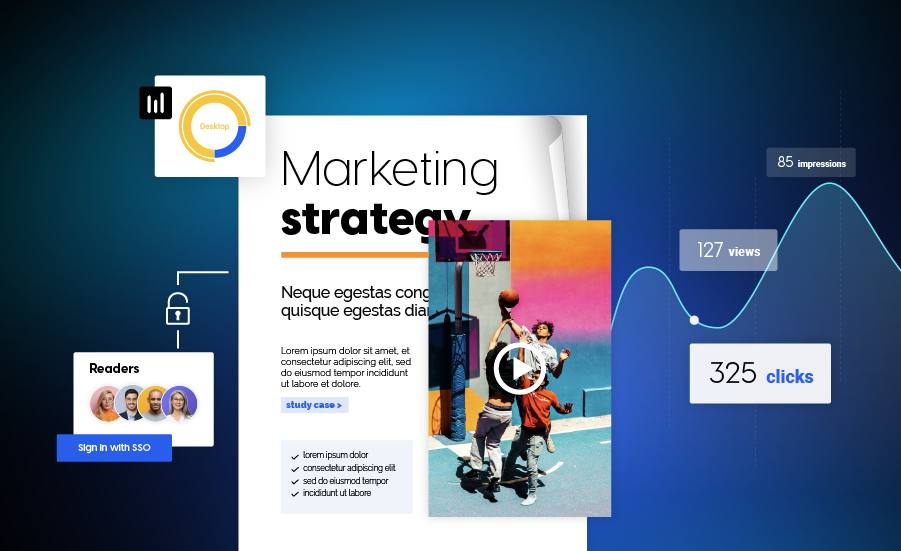
Instead of being limited to links and videos, digital flipbooks can include many other options, such as embeds, product tags, and shopping lists. Features that can cover a wide range of needs.
The importance of digital flipbooks today
Today, flipbooks are created using HTML5, allowing people of all skill sets to advertise and promote their businesses. Some users create marketing materials, others promotional ones, depending on their needs. There are multiple flipbook makers on the market, each excelling in different ways, and companies from different industries use Flipsnack and other digital flipbook makers.
Take Flipsnack, for example. We have thousands of users across various industries that use our platform to create helpful publications. Flipsnack is a pioneer in the flipbook industry, and we’re proud to have made our mark in the history of flipbooks and to be at the forefront of ingenuity and their evolution in the digital era.
At Flipsnack, we’ve made it our mission to make flipbooks accessible to anyone and everyone. We want to lead the charge into the paperless future, one PDF flipbook at a time.
We have real estate agencies and agents, retailers and wholesalers, travel agencies, universities and schools, and many more that use our product. They create guides, brochures, catalogs, flyers, and other types of publications that help their needs.
Let’s take a closer look at the following section:
Digital flipbooks for different industries
Here are some of the ways our tool can help different industries. I have included five different industries, highlighting the types of content they create, the features they are interested in, and a brief explanation of how they use us. For each entry, I have also included a template representative for the domain. An inspiration that can help you get started.
Digital flipbooks for real estate
Types of content they create:
- Listing presentations
- Real estate brochures
- Market reports
Features they are interested in
- Virtual tours
- MLS integration
- User roles
How do they use Flipsnack?
Companies from the real estate industry are interested in helping their agents sell more properties. The importance is for agents to be able to create their real estate materials quickly and share them with their prospects easily. This means sharing the publications via link, email, or other ways.
One important feature is the MLS integration, through which users can integrate their MLS database in Flipsnack. With this feature, they don’t need to create separate brochures for each property. They create a single one and can change the property information with a single drag-and-drop.
As you flip through their publications, you’ll see links, images, and other details to help prospective buyers decide whether the property suits them. However, interactivity options do not stop there, as some of them even embed virtual tours of the property, which is handy as it allows clients from any location to take a sneak peek of the property.
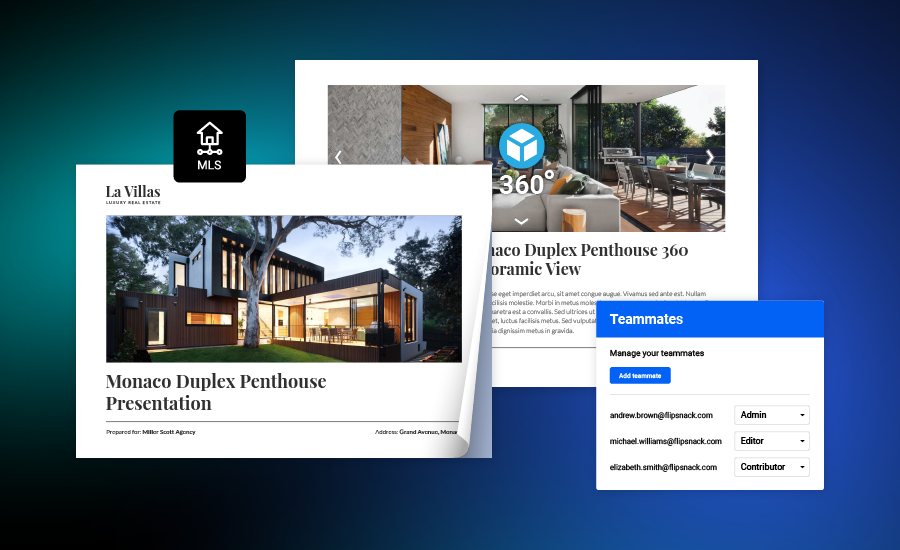
Digital flipbooks for travel
Types of content they create:
- Promotional brochures
- Promotional flyers
- Leisure guides
Features they are interested in:
- Photo slideshows
- Embeds
How do they use Flipsnack?
Hotels and tourism agencies aim to promote their deals and offers to attract potential clients. They often create brochures and guides to inform people about accommodation and travel options and market their services.
One of the main advantages of using Flipsnack is that it allows for easy digital sharing, eliminating the need to print promotional materials. This helps them reduce waste, cut costs, and save time. Some start with a template, others upload a PDF, and others create the entire travel publication from scratch.
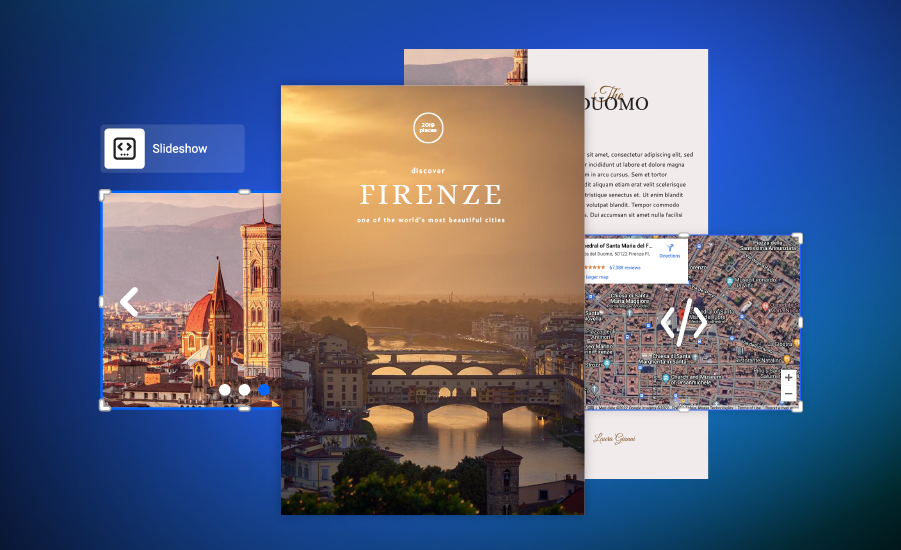
Interactivity-wise, there are different popular elements usually included in a travel brochure. Links, videos, or slideshows work great, allowing travelers to get a better glimpse of the location. Embeds, such as maps or virtual tours, are also very efficient.
Larger companies may have more specific requirements, such as branding or multiple-user access.
Digital flipbooks for the medical field
Types of content they create:
- Promotional brochures
- Medical research publications
- Patient educational materials
Features they are interested in
- PDF Upload
- Interactivity
How do they use Flipsnack?
Companies from the medical industry use Flipsnack in different ways. Some companies create catalogs to promote their products or services, others publish research papers. It depends on the field. Some create a brochure for medical services using one of our medical brochure templates. Others might provide all the necessary information about the latest medical gear packed neatly in a PDF flipbook.
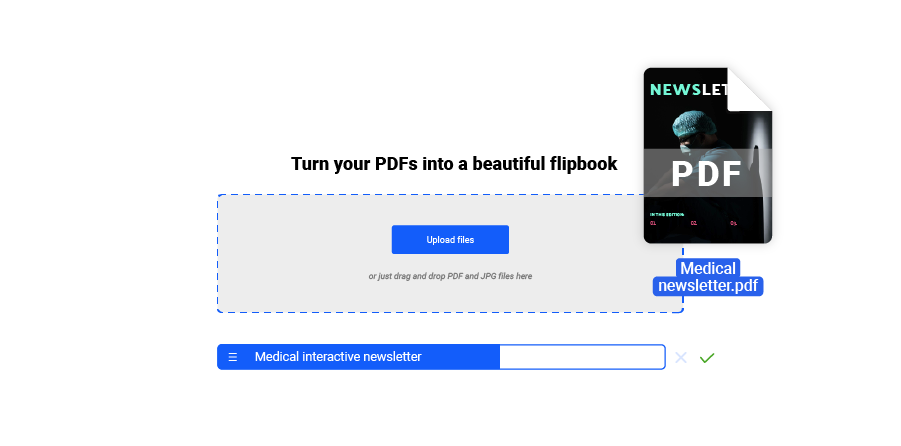
Professionals in the medical industry can use Flipsnack to enhance their communication and education strategies. Flipsnack makes it easy for them to create engaging materials for patients, staff, and stakeholders.
Digital flipbooks for retail and wholesale
Types of content they create:
- Product catalogs
- Wholesale catalogs
- Gift guides
- Lookbooks
Features they are interested in:
- Shopping list
- Product tags
- Statistics
How do they use Flipsnack?
Retailers and wholesalers from different industries, such as fashion, tech, interior design, and more, use Flipsnack to create interactive digital catalogs to promote their products. They also create magazines, brochures, or gift guides.
Using digital publications instead of printed ones allows them to cut costs and reach their audience more quickly, which is very useful, especially if they operate on a global market.
Interactivity is the name of the game, and they take advantage of different interactive features. Product tags, for example, allow them to draw attention to specific products. Many also use our catalog automation and shopping list feature.
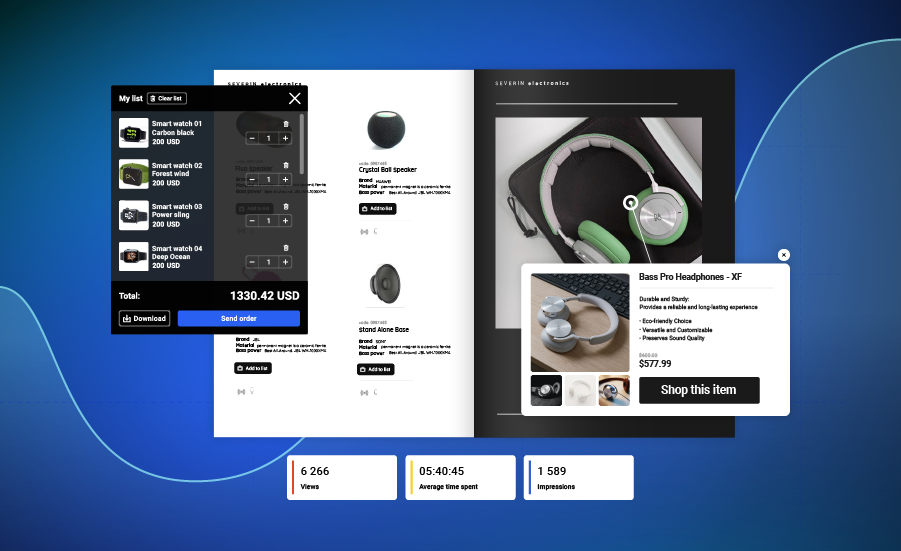
Users can import a spreadsheet containing all their products and easily populate their catalogs with a drag-and-drop. Customers can directly add products to their shopping list, which they can email to the seller, thus eliminating the back-and-forth and streamlining the shopping process.
Sellers also use statistics to understand how their clients interact with their publications. Branding is also essential, so they upload their brand kit and use it when creating their publications.
Digital flipbooks for internal communication
Types of content they create:
- Employee handbooks
- Onboarding guides
- Company reports
- Internal newsletters
Features they are interested in:
- Security
- Private sharing
- Statistics
How do they use Flipsnack?
Customers from the internal communication department create and share internal documents, such as newsletters, training or onboarding materials, employee handbooks, company reports, and more. By using Flipsnack for these purposes, a company can transform its internal communications, making them more interactive, visually appealing, and engaging for employees. This not only improves the delivery of information but also contributes to building a positive and well-informed workplace culture.
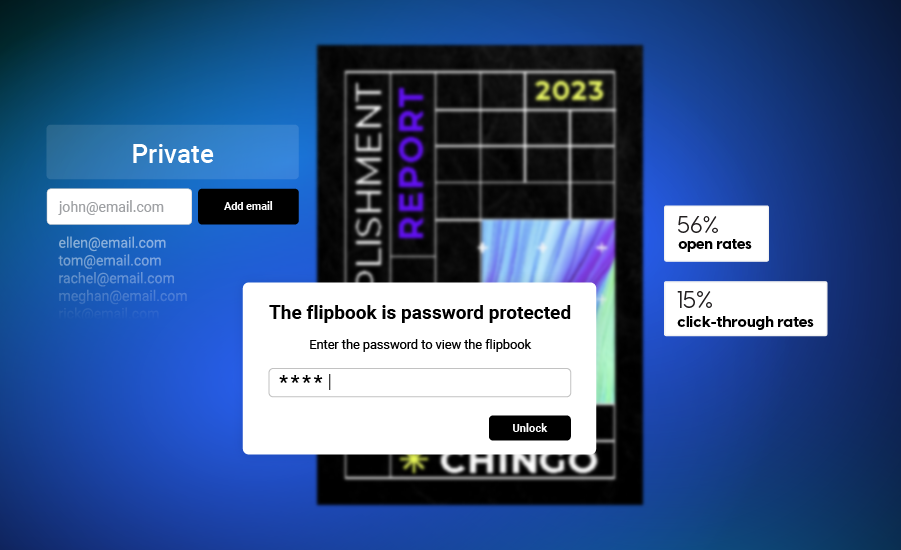
Since these documents contain private internal information, security is essential. To ensure the security of private internal information, companies prioritize restricting access to these documents to employees. They achieve this by using features like password protection, sharing with specific people, or enforcing single sign-on (SSO) login.
Statistics are also important, as it allows them to see if employees have opened the internal documents and how they have engaged with them.
FAQ
Here are some common questions regarding digital flipbooks:
Digital flipbooks are generally more cost effective than traditional printed materials due to savings on printing and distribution costs. Unlike physical printing, which requires spending on materials like paper and ink, plus shipping, digital flipbooks eliminate these expenses. They involve initial software and design costs but can be distributed online endlessly without additional per-unit costs, making them especially economical for materials that need regular updates.
Yes, digital flipbooks can be integrated with various digital marketing tools to enhance their reach and functionality. They can be embedded in websites, linked in emails, or shared on social media, making them easily accessible. Additionally, they can include tracking features that provide valuable insights into user engagement, allowing for more targeted marketing efforts and continuous optimization of content strategy.
Digital flipbooks are designed to recreate the immersive experience of reading a physical publication in a digital format. Also known as online flipbooks, these interactive publications allow users to flip through pages using a realistic page-turning effect.
While a flipbook can be created from a PDF, there are major differences between the two:
Interactivity – PDFs are more static and basic, offering limited interactions. Flipbooks are interactive and feature realistic page-turning animations, embedded videos, audio, and interactive elements.
Distribution – PDFs are distributed as standalone files, often as downloads or attachments. Flipbooks can be sent via a direct link, directly on social media, embedded on websites, and more.
Analytics – PDFs offer limited analytics, providing basic information about metrics like opens and downloads. Flipbooks offer advanced analytics, including user engagement, page views, devices, location, time spent on the page, and others.
Security – Once a PDF has been downloaded, it can be shared with anyone without any problems. Flipbooks offer advanced security options such as sharing with specific people, SSO authentication, or password protection.
Updating the content – If you find any typos or need to make updates to a PDF file, you must create a new file and share it again. Since flipbooks are shared via a link, you can make changes directly on the original link without having to create a new flipbook.
Yes, you can convert a PDF into a flipbook. The process is straightforward: upload the PDF and wait for the conversion to complete. Once done, you can add interactivity to it. Basically, you turn a static document (PDF) into an interactive reading experience (flipbook).
Flipbooks can be SEO-friendly, but you must take certain actions to optimize them properly and rank higher in search results. For example, you should set meta titles and meta descriptions and populate the content with relevant keywords.
Yes, most of the market’s flipbook makers allow you to download your flipbook. The type of download depends on the platform. Some offer the option of downloading your flipbook as an image, while others also allow you to download as HTML5, GIF, MP4, and more.
Each platform offers different ways to create your flipbook. In Flipsnack, you have three options: create the flipbook from scratch in our Design Studio, use a pre-made template that you can edit, or upload a PDF file and make it interactive. Regardless of the method, the process is simple and does not require technical expertise.
The future of digital flipbooks
We’ve talked about the history of flipbooks, so naturally, we need to talk about the direction they will take in the future. The truth is that flipbooks have unlimited potential. As more and more people gravitate towards digital mediums, flipbooks will become more and more relevant for various applications.
Flipbooks have revolutionized the way businesses operate. They have transformed marketing materials from simple documents into interactive experiences, increasing sales conversions and brand awareness and making creating and sharing new flipbooks easier.

The future of flipbooks is bright and always pushing forward. Technology like easy drag-and-drop capabilities, integrations with APIs and databases, or entire workspaces dedicated to creating and collaborating with certain people is a reality we can now indulge in.
Digital flipbooks are predicted to focus mainly on two paths: user experience and sustainability. Improving the user experience can involve expanding interactive elements such as virtual reality (VR) and directly incorporating the use of AI (some tools already offer this feature). Sustainability will be important as more and more businesses will want to reduce waste and make a shift from printed materials to digital ones.
If the history of flipbooks provides any foreshadowing, we can be sure that flipbooks, their accessibility, ease of use, interactivity, easy sharing, and their applications will get better and better. They’re already changing the business, education, and entertainment world, so we can’t wait to see what the future holds.
